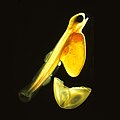Atlantic salmon: Difference between revisions
CSV import Tags: mobile edit mobile web edit |
CSV import |
||
| Line 25: | Line 25: | ||
[[Category:Fish described in 1758]] | [[Category:Fish described in 1758]] | ||
{{Fish-stub}} | {{Fish-stub}} | ||
<gallery> | |||
File:Salmo_salar.jpg|Atlantic salmon | |||
File:Atlantic_salmon_Atlantic_fish.jpg|Atlantic salmon | |||
File:Salmo_salar_juvenile.jpg|Atlantic salmon | |||
File:Ocean_migration_of_Altantic_salmon.gif|Atlantic salmon | |||
File:Life_Cycle_of_Atlantic_Salmon.svg|Atlantic salmon | |||
File:Salmoneggskils.jpg|Atlantic salmon | |||
File:Salmonlarvakils_2.jpg|Atlantic salmon | |||
File:Atlantic_salmon_redd.jpg|Atlantic salmon | |||
File:Atlantic_salmon_parr.jpg|Atlantic salmon | |||
File:Salmo_salar_smolts.jpg|Atlantic salmon | |||
File:Original_Fish_Pass_on_the_dock_feeder_weir_Port_Talbot.jpg|Atlantic salmon | |||
File:Wenceslas_Hollar_-_Salmon_fishing_(State_1).jpg|Atlantic salmon | |||
</gallery> | |||
Latest revision as of 11:02, 18 February 2025
Atlantic Salmon (Salmo salar) is a species of ray-finned fish in the family Salmonidae. It is found in the northern Atlantic Ocean and in rivers that flow into the North Atlantic and, due to human introduction, the North Pacific.
Taxonomy[edit]
The Atlantic Salmon was first scientifically described by Carl Linnaeus in his landmark 1758 10th edition of Systema Naturae. It is the type species of the genus Salmo.
Description[edit]
Atlantic Salmon are silver-blue with a slightly darker back. They have a streamlined body with a large mouth and sharp, pointed teeth. The average weight of an Atlantic Salmon is between 8 and 12 pounds, but some individuals can grow up to 30 pounds.
Distribution and habitat[edit]
Atlantic Salmon are native to the rivers on both sides of the North Atlantic. They have also been introduced into the Great Lakes of North America. Atlantic Salmon are anadromous, meaning they can live in both fresh and salt water. They spend one to four years in their natal river, then migrate to the ocean, where they also spend one to four years.
Life cycle[edit]
The life cycle of the Atlantic Salmon begins with the female laying eggs in a 'redd', a nest made in the riverbed. After hatching, the young salmon, known as 'fry', remain in the river for up to four years before undergoing a process called 'smoltification', which allows them to survive in salt water. They then migrate to the ocean, where they grow rapidly.
Conservation[edit]
Atlantic Salmon populations have declined in recent years due to a variety of factors, including overfishing, habitat loss, and climate change. Conservation efforts are underway to protect and restore Atlantic Salmon populations.
See also[edit]
-
Atlantic salmon
-
Atlantic salmon
-
Atlantic salmon
-
Atlantic salmon
-
Atlantic salmon
-
Atlantic salmon
-
Atlantic salmon
-
Atlantic salmon
-
Atlantic salmon
-
Atlantic salmon
-
Atlantic salmon
-
Atlantic salmon











